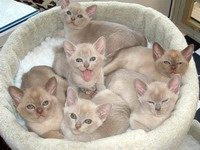Kitten weaning from mother
 Excommunication from the mother is the transfer of the kitten to independent feeding and adaptation to life without a mother cat. The most favorable for this is the age of 10–12 weeks. By this time, the kitten can already do without mother’s milk, goes to the cat’s tray and licks itself, and its psyche is stable enough to move to a new place without harm.
Excommunication from the mother is the transfer of the kitten to independent feeding and adaptation to life without a mother cat. The most favorable for this is the age of 10–12 weeks. By this time, the kitten can already do without mother’s milk, goes to the cat’s tray and licks itself, and its psyche is stable enough to move to a new place without harm.
How to prepare a kitten for this difficult event?
Switch to self-catering
In the first days of a kitten’s life, a cat feeds them with a special “primary milk” – colostrum, which contains a large amount of antibodies (especially IgA and IgG) and promotes the development of the baby’s own immunity. Under normal conditions, kittens continue to feed on mother’s milk for up to 1.5 months.
However, already at the age of 4-6 weeks, you can gradually accustom the kitten to self-feeding, offering him a little wet food. When choosing a pet food ration, it is important to understand that cat milk is a high-calorie product containing 2 times more protein than cow’s milk, rich in macro- and microelements, vitamins and essential fatty acids necessary for the growth and development of the animal. Of course, the food offered to the kitten must also meet all of the above qualities. One of the feeds most suitable for switching from dairy to self-feeding is the wet PRO PLAN® Junior NUTRISAVOUR®. It contains all the necessary nutrients for the harmonious development and growth of a kitten: polyunsaturated omega-3 fatty acids to maintain brain development and vision, as well as the correct ratio of calcium and phosphorus for the development of the musculoskeletal system.
At the age of 7–8 weeks, dry food can be added to the kitten’s diet, completely discarding mother’s milk. It should be remembered that during this period of life the kitten is especially vulnerable to infections, since it has not yet formed its own immunity, and the antibodies contained in human milk no longer flow. To ensure maximum support for the kitten’s immune system during this period of life, PRO PLAN® Junior dry food containing a unique OPTISTART® complex is perfect. This complex not only fully provides the kitten with all the necessary nutrients, but also contains dry colostrum, rich in antibodies and helping to strengthen the resistance of the intestines and the development of immunity.
From 8 weeks of age, the kitten can be completely transferred to feeding on dry food, but it is equally advisable to continue combined feeding. The amount of both foods should be determined according to the instructions for determining the total caloric intake. It is extremely important to provide the kitten with constant access to fresh water, regardless of whether you feed it with wet or dry food.
Up to 12 weeks of age, the kitten must be fed 5-6 times a day. So that your pet does not feel hungry and can approach the bowl as many times as it needs, it is more convenient to use dry food, as it can stay fresh for much longer. However, in order to diversify the diet and provide the pet with sufficient moisture, it is useful to keep both a kitten and an adult cat and a wet food in the diet.
After you take the kitten to your home, it is important to feed the pet with the same food as before weaning from the mother. This will help him to adapt to a new place and reduce the risk of gastrointestinal disorders.
Socialization
To adapt to life without a mother in a new place, a kitten needs to pay a lot of attention: ironing, “talking”, playing. It is good to teach him that there are other people who will also do no harm, but, on the contrary, will give him pleasant emotions. If possible, engage in communication with the kitten of all family members (residents of the apartment). It will be useful if you meet and play with your future pet even before his weaning from the mother cat. So the kitten will treat you with great confidence, and getting used to a new place of residence will be much easier for him.
Schooling to the tray
Up to 4 weeks of age, a cat carefully cares for its kittens and licks their feces. But when kittens reach this age, it becomes necessary to accustom them to the tray. Most often this is not too problematic: if you put the tray in the same room with the kittens, they will quickly begin to repeat after the mother – go to the same tray. The main thing here – to monitor its purity and in time to change the filler. Remember that no cat wants to go to a dirty tray, and weaning a kitten from the habit of walking past will be much more difficult. In addition, the kitten will be much easier to adapt to your home, if at first, you will use the filler for the tray, to which he was accustomed next to his mom and cat.


